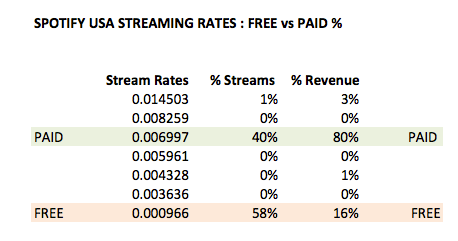December of last year Billboard changed the way it calculates it’s album charts. The publication once hailed as “The Bible of the Music Business” last year announced that it would count 1500 streams as the equivalent of an album sale. While I welcome the addition of a streaming component to the charts, I believe that Billboard may be overweighting free streams in order to help streaming services keep artists on the free tiers of streaming services. Let me explain.
The 1500 streams were supposedly based on the approximate rate that streaming services pay per spin. At $0.005 a spin to rights holders the $7.50 generated by 1500 spins is close to the $7.00- 9.00 rights holders net on an iTunes album sale. Ed Christman detailed and previewed these changes last fall in Billboard before they were formally implemented. This was clearly part of the logic of the change.
But since that time we have discovered that Spotify free tier does not pay anything close to that. Our examination of the revenue generated by a moderately sized indie catalogue shows that in the US Spotify free tier generates $0.0009 per spin. So 1500 plays on the Spotify free service really only generates $1.35. YouTube generates a similarly low amount per 1500 spins. By our calculation YouTube pays $0.00175 to all rights holders per spin (including video!). That’s $2.63 for 1500 spins. So on Spotify free platform the revenue equivalent of an album sale would require more like 8000 streams and on YouTube more like 4300 streams.
Objectively we can conclude that in terms of revenue both YouTube streams and Spotify free plays are vastly overweighted compared to sales.
Now let’s put this in context. What happened at the end of October/ beginning of November? Taylor Swift released an album that she tried to place only on the paid or premium tiers of the streaming services. Or in other words she tried to withhold her full album from the free tier of the streaming services. Both YouTube and Spotify refused to do this. As a result Swift’s new album did not appear on these two streaming services at all. Largely unreported was the fact that Swift wasn’t making an anti-streaming statement, indeed she left key parts of her catalogue on the premium Rdio service.
Wait! This isn’t the way the mainstream press and Billboard first reported it? That’s right. Ever wonder why? In the case of the mainstream press they may have innocently missed this subtlety. But Billboard? The Bible of the Music Business? You got to wonder.
This wouldn’t be the first time that Billboard has seemingly engaged in very Hearst like reportage to prop up a streaming service in trouble. When we broke the story that Pandora founder Tim Westergren had repeatedly contributed funds to a congressman that tried to have Washington DC’s gay marriages voided, Billboard quickly stepped in with this piece by Andrew Flanagan to defend Westergren. Flanagan seemed to find some sort of “balance” in Westergren’s donations that canceled out those donations to a gay baiting congressman. Interesting. An unusual argument for a NYC based, sometimes NPR reporter to make. I wonder if he’s ever tried this argument out on his gay neighbors?
But I digress. The point is this: Treating Billboard as an unbiased observer in the music industry battle over streaming is becoming a sketchy proposition. It has clearly become a partisan player in the battle over streaming. And you have to wonder if the curiously timed changes to the Billboard charts are not part of this battle. Because now if an artist wishes to “chart” they will have to think twice about removing their songs from YouTube or Spotify.
How convenient for the streaming services!


You must be logged in to post a comment.